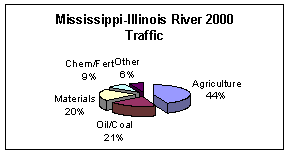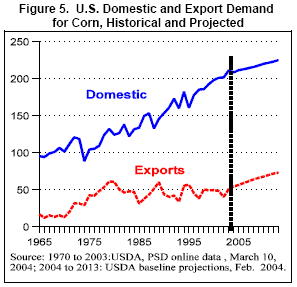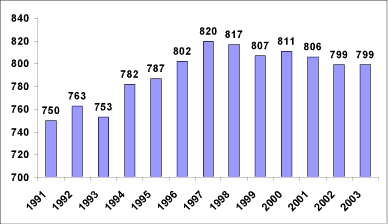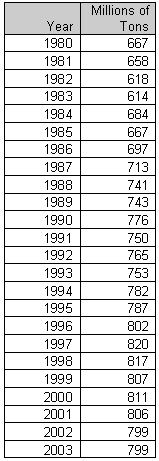Home
Introduction
Components
One
Two
Product
Three
Background
Accidents
Barges
Carbon Fiber
History
Navigation
Ports
Sonar
Steel
Towboats
Project
Assessment
Bibliography
Glossary
Team

|
|
Component Three
Provide a forecast of what the workforce demand would be over
a five-year period to produce and market your team’s technical application or process.
Include the impact such production would have on the marketplace.
In America, the demand for raw, natural resources is high. Catering to a global community, we are obligated to deliver these items in a
timely fashion and with maximum efficiency. Given these aspects of trade, we are
faced with challenges in providing the best possible source of transportation that
will not only be beneficial in a monetary sense, but will also have positive environmental
impacts. Barges are the perfect candidate.
Fact: "Barges
safely and efficiently move fully 15 percent of our nation’s freight for less than
2 percent of the total bill"… and "move more than 800 million tons of cargo each
year!"
The
chart to the right shows the major markets impacted by the barge industry
on the Mississippi River and Illinois Waterway during 2000.
The
two following diagrams from the National Council for Science and the Environment
show an extrapolation of the demand for corn and soybeans based on the data from
the previous 40 years.
|

Courtesy of
The American Farm Bureau
|
 |
 |
Fact: "A study
by the U.S. Army Corps of Engineers notes that traffic on the Upper Mississippi
River will steadily increase between the years 2000 and 2050 growing by about 63
percent over those years. The same forecast predicts an average growth rate of 2
percent per year on the Upper Mississippi River during the remainder of the 1990s."
The employment of barges is fundamental as we maintain our prosperous economy and compete in the global market. In fact, as depicted in the
following graph and chart1, the entire
barge industry has grown from moving 667 million tons in 1980 to moving 799 million
tons in the year 2003.

Images used with the permission of
Doug Scheffler1
According to Mr. Doug Scheffler2, AWO's research
and data analysis manager,
"the number of towing vessels in the inland sector of the towing industry is fairly
stable, about 3,500 in the last few years, and the utilization rate has been simarly
stable, so the number of jobs has been fairly stable."
Although our product would not have a significant impact on personnel since it's
management would not impact the size of a towboat's crew, it may have an economic impact
beyond the decrease of repairs and damages resulting from the reduction of the accident-rate.
|
 |
Again referencing Mr. Scheffler's February 25th email2,
"regarding the economic impact, your analysis of the damages data provides a static
analysis. For a more dynamic analysis I would mention that not only with the out-of-pocket
repair costs there is what economists call the opportunity costs. That is, while
a barge or towing vessel is being repaired, the revenue that it could have earned
if it was on the water is lost. So any device that reduces vessel casualties will
also reduce repair costs will also have a positive impact on revenue by improving
the utilization rate."
The North
American market for the carbon material industry is projected to
increase in sales from $639 million from the present to about $878 million in 2011.
In total, the North American Market’s carbon industry as a whole increased by 6.6%,
reaching $2.2 billion in 2011. Based on an increase in North America's carbon industry,
we believe our product will spur additional demand, increase profits and the growth
of the industry, because it will encourage other developers to use carbon fiber
in non-traditional applications. The graph below shows the predicted increase in
North America's market for advanced structural carbon materials.
SP Systems,
a global manufacturer of advanced composite materials and technology solutions,
specializes in marine, wind energy, and automative applications for composite materials.
It has grown from a small company, started in 1970, on the Isle of Wright to a company
that grossed £50 million in 2002 and currently has offices on four continents.
With respect to our product, on February 21, 2006, Mr. Hammatt3
of New England
Boatworks, Inc. stated that his ability to work with carbon fiber has positively
influenced his company's sales.
Give two examples of undergraduate or graduate degree programs
in science or engineering that directly relate to your team's NCT technical application.
For each program, be sure to include the following:
 the URL address of the institution, the URL address of the institution,
 the department (for example, chemical
engineering, electronic engineering) where the program is offered, and the department (for example, chemical
engineering, electronic engineering) where the program is offered, and
 a brief description of the program of
study.
Due to the scope of our project, we felt it was necessary to examine three undergraduate
programs to solidify the varied pre-requisites present in our technical application. a brief description of the program of
study.
Due to the scope of our project, we felt it was necessary to examine three undergraduate
programs to solidify the varied pre-requisites present in our technical application.
The United States Naval Academy
houses a whole host of maritime courses that are aimed at the engineering aspect
of maritime activity. In addition to their core curriculum of: engineering, natural
sciences, humanities and social sciences, professional and leadership skills, which
is aimed at teaching the skills required to create competent officers for the Marine
Corp and the Navy, they offer courses that range from the basics of ship design
to advanced material mechanics.
- Principles of Ship Performance and Naval Architecture
- Ship Structures, Hydrostatics and Stability
- Naval Materials Science and Engineering
- Ship Design
- Navigation and Piloting
A major goal
of the Naval Architecture and Ocean Engineering program:
You will be an engineer, a naval architect, and an individual who is capable of
finding viable economical and technical solutions to a variety of complex and open-ended
engineering problems, such as, how to safely and efficiently move a variety of cargoes
across the world’s oceans (cruise liners, tankers, containerships, heavy lift ships,
tug-barge units, etc.).
The USNA’s courses would be vital for one interested in the principles of naval
architecture and the basic function and design of any marine vessel.
The Maine Maritime Academy
specializes in educating individuals in the feild of piloting and maintaining maritime
vessels. Their merchant marine academy trains persons in two aspects of maritime
service: that of piloting a vessel or that of servicing and maintaining a vessel.
The Maine Maritime Academy strives to continue to provide the highest quality maritime,
engineering, engineering technology, marine science, and logistics education with
facilities and laboratories that are at the leading edge of technological innovation.
- Marine Engineering Fundamentals
- Intro to Marine Transportation
- Ship Handling
- Seamanship
- Navigation
These courses would be vital to anyone interested in piloting a vessel using our
device.
The Mechanical, Materials,
and Aerospace Engineering Department at the Institute of Technology has
all of its classes accredited by the Engineering Accreditation Commission of the
Accreditation Board for Engineering and Technology (ABET). Its school of engineering course work is the same for the first
two years allowing students to easily change and/or add their majors and minors.
The undergraduate
programs that would apply to preparing a student to work with our product
would include:
- Composites
- Structure/ Property Relation in Polymers
- FIBER Reinforces Poly Comp Materials
- Physical Metallurgy
- Introduction to Polymer Science
- Materials Laboratory II
- Physics of Solids
These courses from IIT would be vital for one interested in the modification, production,
or repair of our centerboard.
Develop an idea for a new science and/or engineering degree program
that might emerge given the advancements in scientific knowledge that the team has
identified. Provide a title and 100-word description of this new degree program.
In addition to building a basic background in marine technologies and sciences,
our graduate program will enable our students to use, repair, modify, and/or build
our product. The research we conducted will hopefully instill a better understanding
of the mechanics and materials involved in marine transportation. We have developed
a comprehensive degree program for those who wish to seek further education in this
particular marine-based technologies field.
Our Master's degree program, Marine Science Technologies and Applications
(MSTA), will inculcate into students such attributes as the ability to
work in teams and meet deadlines.
Our internship during the second year will give them the opportunity to gain real-world experience.
These three criteria were listed by Matt Hammatt3
of New England Boatworks, Inc., as being important attributes of prospective employees.
|
|
Year One |
Year Two |
|
Hydromechanics |
Hydrodynamics |
|
Electronics |
Environmental Systems
|
|
Marine Engines |
Naval Vessel Design
|
|
Chemistry of Polymers
|
Composite Materials and Applications
|
|
Seamanship |
Advanced Navigation and Piloting |
Internship
|
Internship
|
|
*electives |
|
*Mechanical Engineering |
*Electricity and Electronics II |
|
*Hydrography |
*Marine Engines II |
Dave Hanby4, President and Chief Operations Office
of McDonough Marine Services stipulated that any potential towboat captain is
"required to have a valid license issued by the US Coast Guard. This license ensures
the holder is qualified to operate towboats in the geographical area they intend
to work. The Coast Guard regulations have changed in recent years to require specific
periods of time working under an apprentice program to allow experienced operators
to train mariners trying to advance."
He also added that they would be interested in hiring
"a licensed captain that preferably has operated the type of equipment we own, may
have pushed the types of barges and cargos we move and has not had any incidents
in the past."
American Farm Bureau: Economic Reasons to Improve Locks on
the Mississippi River & Illinois Waterway
http://www.fb.org/issues/analysis/MS-IL_waterway.html
American Iron: Economy of Barge Transportation
http://www.scrappy.com/BargePage05.htm
The American Waterway Operators: The Value to the Nation
http://www.americanwaterways.com/value.pdf
Barge Employment
http://www.ingrambarge.com/barge_employment.asp
BCC Research
http://www.bccresearch.com/editors/RGB-263R.html
Matt Hammatt
3email correspondance:
February 21, 2006
Dave Hanby
4email correspondance:
February 21, 2006
Illinios Institute of Technology
http://mmae.iit.edu/academics_ug/coursework.html
http://mmae.iit.edu/academics_ug/index.html
Doug Scheffler
1email correspondance:
February 24, 2006, attachment
2email correspondance:
February 25, 2006, attachment
Water Transportation and Merchant Mariner Careers and Jobs
http://www.careeroverview.com/water-transportation-careers.html
|
|

